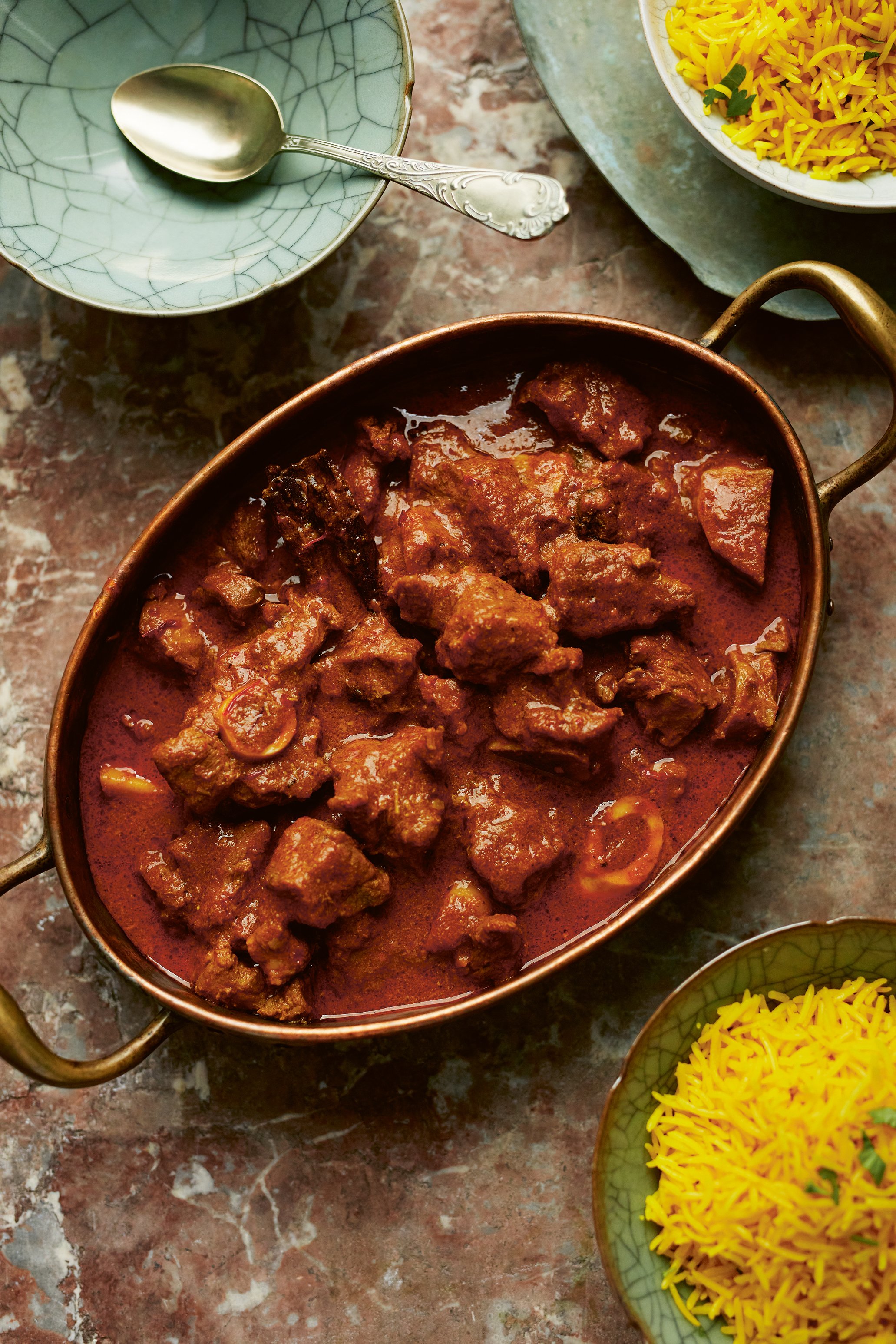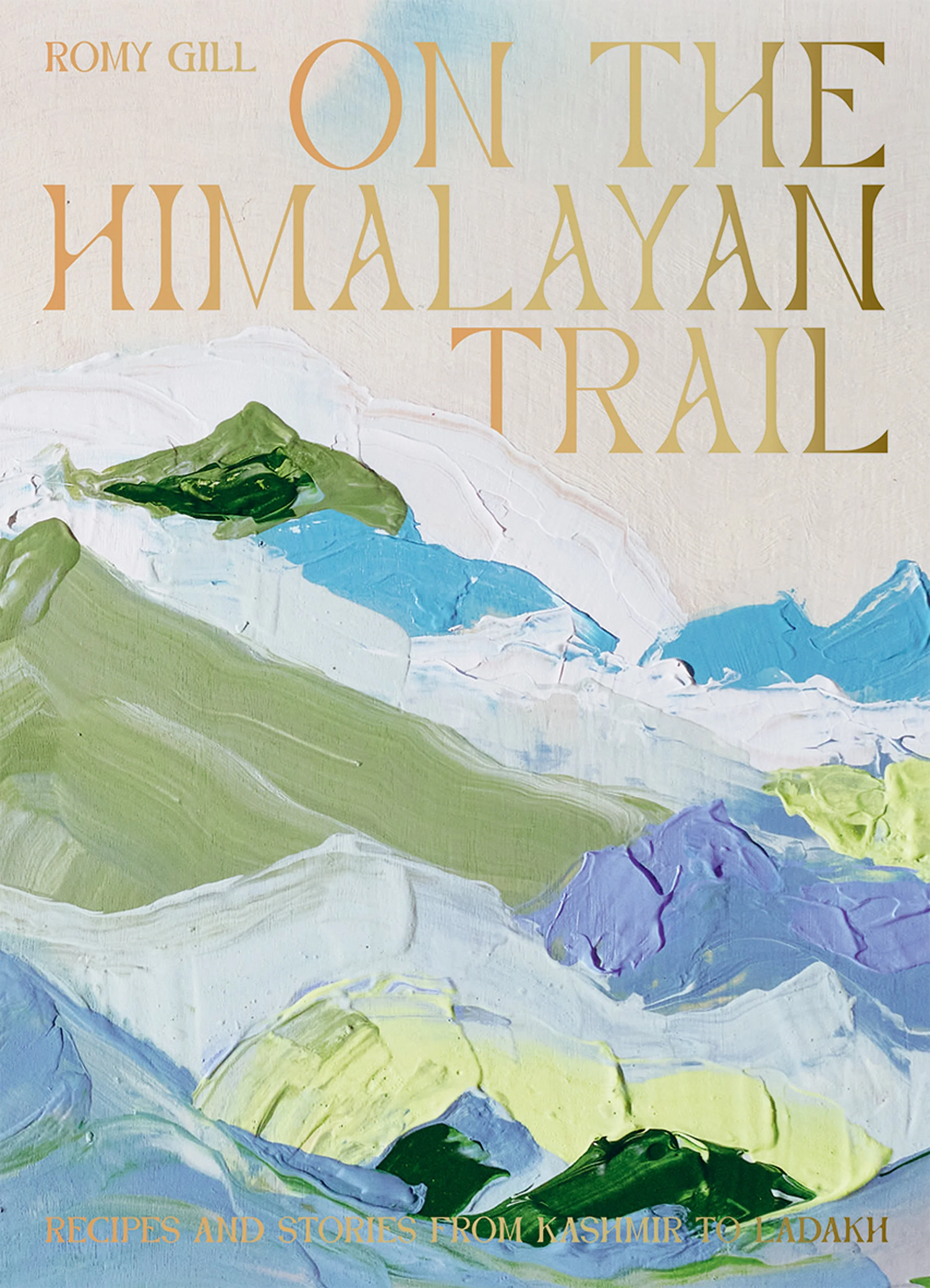Kashmir Tastes
The Indian-born chef talks about the power of travel, and the warmth of Kashmiri cuisine.
Despite growing up in West Bengal and speaking five Indian languages fluently, Romy Gill admits there’s still plenty she doesn’t know about her home country.
This is down to the vastness of India, and Gill wants people to recognise “it’s very diverse, with very different people – we speak different languages, we look different, we have very different rituals”.
She’s particularly enthralled by the area of Kashmir, in the north of India near the Himalayas, because of her adventurous husband’s stories. “He used to travel there when he was in university in Punjab, he used to travel on a scooter,” she says wistfully. “When we got married, he used to show me all these photographs – and I always wanted to go there.
“Even if you’re in India, you don’t necessarily know everything about India, Indian food and Indian people,” she adds. Growing up in West Bengal to Punjabi parents, Gill – who is based in the UK and a regular face on TV shows like Steph’s Packed Lunch and James Martin’s Saturday Morning – admits she “disliked cooking” as a child. But she “loved eating”, and says with a laugh: “I would go to my neighbours’ house and say, ‘My mum hasn’t fed me!’ – when they knew she fed me. I would eat their food and then go to my friend’s house” – and the cycle would continue.
Gill recognises her family was somewhat unique, because her father cooked alongside her mother. “He found his sanity in cooking, he found sanity in helping my mum,” says Gill, remembering how they would make pickles together.
“They would have bickering fights together,” she adds – but she fondly remembers “the love and the passion they had to cook”, and her dad has been “such a huge influence” on her.
Now though, Gill is looking outside of her family for her second cookbook, On The Himalayan Trail: Recipes And Stories From Kashmir To Ladakh.
As the northernmost state in India, Gill describes Kashmiri cuisine as having “so many influences” – from central Asia, Persia, Britain and beyond. It’s particularly known for the wazwan, a Kashmiri banquet that is steeped in tradition. Gill says she was “fascinated by the wazwan”, likening it to the ‘nose to tail’ movement, because chefs “use each and every part of the animal, and make beautiful things with it.
“They’ll bring out lots of different dishes, and you share it,” she adds of what would happen at a wazwan – making it the best way to get a full picture of food in the area.
You’ll find “lots of ginger powder, fennel powder, cinnamon – all these floral, warming spices, because Kashmir is very cold”. There’s also Kashmiri chillies, but they won’t blow your head off – instead they have a “beautiful colour, warmth – richness, but not heat”, she notes.
Gill has written a cookbook full of colourful recipes, but it reads almost like a travel book. When asked about it, she talks excitedly and rushes out her words, reminiscing about her travels around the region.
“It’s about people,” she says simply. “It’s not just about me – it’s other people’s stories.” Instead of calling it a cookbook, Gill lovingly refers to it as “my diary”.
That’s not to say her travels were easy – particularly as she wanted to do firsthand research, so had to make multiple trips between her home in England and Kashmir during a global pandemic. In one particularly hairy situation, Gill had “a very small window to visit in 2020 to meet the saffron producers” – with two weeks to see the saffron crocus bloom.
Luckily, she navigated Covid tests and international flights and got to see the flowers in bloom, meeting various farmers to understand how integral this crimson spice is to Kashmiri food.
Gill really comes alive when talking about the people she met on her travels – she’s a big fan of sitting down and cooking with the locals. “I followed that philosophy all through,” she says. “I didn’t think, ‘Oh, you’re a poor person’… I would go sit with them, cook with them, eat with them.
“I think that’s so important – that’s when they open their stories,” she adds. She also wants the book to serve as encouragement for people to go to Kashmir – typically not an area with high volumes of tourism, due to the troubled political history of the region. “I don’t want people to be scared, because the people are so nice,” she says, and they “want to share their heritage”.
Gill continues: “I think you have to take the leap of faith, you have to travel. It makes me feel happy when I meet people, because there’s just so much to learn.”
Aubergines Cooked With Tomatoes
“When visiting Kashmir and Jammu, I saw that thin, long aubergines were popular dishes among the Kashmiri Hindus,” says Romy.
“I am a big fan of aubergines and learning to cook and eat them in different ways is exciting. The sweet, sour tomatoes work well with the aubergines here.”
(SERVES 3)
INGREDIENTS:
◆ 8 long thin aubergines (or 2 large ones), quartered lengthwise, keeping the stem end intact so they are joined at the top
◆ 1tsp salt
◆ ½tsp ground turmeric
◆ 8tsp mustard oil or sunflower oil
◆ 1tsp brown cumin seeds
◆ ½tsp asafoetida powder
◆ 500g tomatoes, chopped
◆ 1tsp ground ginger
◆ 2tsp Kashmiri chilli powder
◆ 100ml water
◆ 2-3 chillies, halved (don’t remove seeds)
◆ Steamed rice, to serve
METHOD:
➊ Place the aubergines into a large bowl and sprinkle with half a teaspoon of the salt and the turmeric. Mix and set aside for 15 minutes.
➋ Heat five teaspoons of the oil in a large pan over a medium heat and fry the marinated aubergines until light brown. Remove from the pan with a slotted spoon and set aside to drain on a plate lined with paper towels. To the same pan, add the remaining three teaspoons of oil, then add the cumin seeds and asafoetida.
When they start sizzling, add the chopped tomatoes and cook for five to six minutes
until they are soft .
➌ Add the ground ginger and chilli powder, along with the remaining half a teaspoon of salt. Add the water and cook for two minutes, then return the fried aubergines to the pan. Add the green chillies and cook for another five minutes, stirring occasionally.
➍ Remove from the heat and leave to rest for 30 minutes before serving with steamed rice.
Bakarkhani (sweet puff pastry biscuits)
“Bakarkhani is the gift of the Mughals to India, along with many other delicious dishes,” says Romy.
“Across India, bakarkhani keep changing in texture, size and shape. When I was in Kashmir, I got to taste a couple of different kinds: one made bakery-style with puff pastry, and the other made with plain flour, milk and ghee, more like a biscuit. I used egg wash to glaze them, but some use milk.”
(MAKES 5-6)
INGREDIENTS:
◆ Plain flour, for dusting
◆ 300g puff pastry (ready-made)
◆ 1 egg, beaten
◆ 2tsp demerara sugar
METHOD:
➊ Preheat the oven to 200°C (180°C fan/400°F/gas 6).
➋ On a lightly dusted work surface, roll out the puff pastry to a rectangle of about 30cm x 10cm, then cut lengthways into five to six long strips.
➌ Roll up each strip into a swirl, then press with your palm to form a round about three to four centimetres thick. Place them on a baking sheet. Brush with beaten egg and sprinkle with sugar.
➍ Bake in the oven for 12–15 minutes. Serve with Kashmiri tea
Muslim Rogan Josh Recipe
This rogan josh recipe hails from the Kashmir Valley, and is “very different to the one we are used to eating in the West”, says Romy.
“Kashmiri Muslims tend to use praan, a type of shallot, plus garlic and cockscomb flower for colouring.”
(SERVES 6-7)
INGREDIENTS:
◆ 1kg bone-in lamb leg, cut into pieces on the bone (ask your butcher to do this for you, if necessary)
◆ 1L water
◆ 15g garlic, crushed to a paste
◆ 1½tsp salt
◆ 2tbsp rapeseed oil
◆ 5cm cinnamon stick
◆ 4 whole cloves
◆ 6 green cardamom pods
◆ 2 black cardamom pods
◆ 3 dried bay leaves
◆ 2tsp ground fennel
◆ 2tsp ground ginger
◆ 2tsp ground turmeric
◆ ½tsp freshly ground black pepper
◆ 4tsp shallot paste (see below)
◆ 1tbsp Kashmiri chilli powder, dissolved in 3tbsp water
◆ 200ml cockscomb flower extract (optional, see below)
◆ ½tsp saffron strands soaked in 4tsp lukewarm water
◆ Steamed rice, to serve
FOR THE SHALLOT PASTE:
◆ 125g ghee
◆ 1kg shallots, peeled and finely chopped
FOR THE COCKSCOMB FLOWER EXTRACT:
◆ 6-7 dried cockscomb flowers (you can buy online or from specialty stores, either whole or ground)
◆ 500ml water
METHOD:
➊ Put the meat in a deep saucepan along with the water, crushed garlic and half a teaspoon of the salt. Boil for 20 minutes until the meat is half cooked. Skim off and discard any scum that rises to the surface. Remove from the heat and strain the cooking stock into a jug. Set the meat aside.
➋ Make shallot paste: Pour the ghee into a heavybased saucepan and heat to 170°C/340°F on a digital thermometer. Alternatively, you can drop in a tiny piece of shallot: if it floats to the surface, then the ghee is hot enough; if it sinks, the ghee is not hot enough yet. Once the ghee is hot, add the chopped shallots in batches and fry until golden brown and crispy.
Remove with a slotted spoon to a plate lined with paper towels to drain and cool. When the crispy golden shallots have cooled down, grind to a fine paste with a pestle and mortar. You must have patience to get the right consistency. Keep grinding until the mixture changes colour to creamy white and the texture becomes like a paste. If you don’t have a pestle and mortar, you can blitz in a blender, but the taste and texture won’t be the same. Store in an airtight container in the refrigerator and use in dishes when required. It will keep for up to a week.
➌ Heat the oil in a large pan with a lid over a medium heat. Add the whole spices and bay leaves and cook for one minute, then add all the ground spices, along with the remaining one teaspoon of salt, the shallot paste and the chilli powder in its soaking water. Stir continuously until well combined.
On The Himalayan Trail: Recipes And Stories From Kashmir And Ladakh by Romy Gill. Photography by Matt Russell. Available now.
➍ If making your own cockscomb flower extract, add six to seven dried flowers to 500ml of boiling water. Leave to soak for 30 minutes, then strain through a muslin into a jar. It will keep for up to two weeks in the refrigerator.
➎ Increase the heat to high and add the boiled meat. Sauté for about four minutes, then reduce the heat to low. Add the reserved cooking stock, cover and cook for 30–35 minutes until the meat is tender. Add the cockscomb flower extract (if using) and the soaked saffron. Mix well, and cook for a final two minutes.
➏ Serve piping hot with rice.









